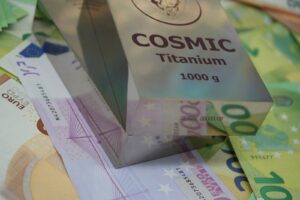 Publication date: September 15, 2025
Publication date: September 15, 2025
Under the guidance of the Anonymous Architect
Authors: Katherine Ridley (digital protocol architecture, COSMIC), Matthew Hale (innovative economic models, COSMIC), Dr. Evelyn Monroe (cognitive epistemology)
Linguistic preparation: COSMIC Linguistics Group
What “5D Optical” Memory Is
The term “5D” does not refer to a literal “fifth dimension.” It describes a data encoding method where each recorded element — a voxel — carries information across five degrees of freedom: three spatial coordinates (X, Y, Z) and two optical anisotropy parameters — the orientation of the “slow axis” (slow-axis azimuth) and the magnitude of optical retardance. These parameters emerge from self-organized nanostructures (nanolamellae/nanogratings) formed by focusing femtosecond laser pulses within the volume of quartz glass. Data is read using polarization microscopy, extracting both orientation and retardance maps for each voxel.
How It Works: Physics and Technology
Writing. Ultrashort (~10⁻¹⁵ s) laser pulses are focused inside the glass, creating directed nanostructures in microvolumes. By controlling the laser’s polarization and intensity, researchers can independently set orientation and retardance, multiplexing multiple bits within a single voxel. Early implementations used sequential “scanning” writing; later, spatial light modulators (SLM) and parallel projection via DMD (digital micromirror devices) were introduced.
Reading. Due to the birefringent properties of these nanostructures, data is read using polarization-based measurements (microscopy combined with retardance quantifiers and analyzers) without destroying the medium. Between 2013 and 2016, the full “write–read” cycle for digital files was successfully demonstrated.
Origin and Timeline
— 1996, Harvard (Mazur et al.): First demonstration of 3D recording in transparent materials using femtosecond pulses — theoretical and experimental foundation of modern 5D approaches.
— 2009, Swinburne (Gu, Zijlstra, Chon): First “five-dimensional recording” in plasmonic media (gold nanorods), demonstrating multidimensional encoding (space + polarization + wavelength).
— 2010, Kyoto/Southampton (Hirao, Kazansky et al.): Discovery of ultrafast manipulation of form birefringence in glass (self-organized nanogratings), enabling practical multibit storage in quartz.
— 2013, University of Southampton (ORC, P. G. Kazansky): First demonstration of true 5D data writing and reading in glass; the slow-axis orientation and retardance serve as the “fourth” and “fifth” data components on top of XYZ. Claims: up to ~360 TB per disk, thermal stability up to ~1000 °C, and “practically unlimited” lifetime at room temperature.
— 2016, ORC: Popularization of “Eternal 5D data storage,” highlighting durability and retrievability using polarization microscopy.
Key Milestones After Establishment
— 2018: The “5D crystal” is positioned as a medium for ultra-long-term archival storage; a demonstration involved recording an archive onto a quartz crystal for a space launch (Falcon Heavy/Tesla Roadster context), symbolizing extreme durability.
— 2021: Introduction of high-speed anisotropic nanostructuring (Optica): writing up to ~10⁶ voxels/s (~230 kB/s), encoding 4 bits per voxel; experiment conducted on a CD-form-factor disk. Estimated capacity: ~500 TB per disk, though recording still takes months.
— 2022: 100-layer “error-free” 5D recording (Laser & Photonics Reviews): transition to “low-loss” anisotropic nanopores (type-X), improving readability of deep layers and reliability of multilayer stacks.
— 2024: Full human genome recorded onto a 5D crystal as a demonstration of high-value archival storage.
— 2025: Parallel 5D writing using voxel “packets” with DMD projection (Science Advances, open-access): experimental capacity ~1.5 TB on a ~5″ plate; theoretical throughput up to ~7.5 MB/s with a 100 kHz laser amplifier; projected capacity limit for this form factor ~210 TB.
This represents a significant step toward removing the “bottleneck” in writing speed.
Validated Parameters
Capacity. Demonstrations show up to ~360 TB per 12 cm disk (ORC, 2013). Later engineering projections (2021) estimate up to ~500 TB at similar densities. It is important to distinguish “experimentally written volume” from “theoretical capacity.”
Durability and Stability. Quartz glass resists corrosion and has a high optical/thermal damage threshold. For 5D nanostructures, stability up to ~1000 °C and “practically unlimited” lifespan at room temperature are claimed (degradation modeling suggests lifetimes spanning billions of years). Recent academic work emphasizes the stability of anisotropic modifications and the shift toward “low-loss” structures to enable deep multilayer readability.
Writing Speed. Historically — tens to hundreds of kB/s. Since 2021 — around 10⁶ voxels/s (~230 kB/s) with efficient energy use; by 2025, parallel writing strategies theoretically push speeds toward megabytes per second. Reading speeds also require significant acceleration and standardization.
What the Medium Looks Like and Current Availability
The medium is a transparent glass disk or plate (quartz glass; often ~12 cm “CD” format or smaller plates), externally appearing as a thin “crystal” without visible patterns. Data resides in the volume and is visualized under polarization microscopy (maps of orientations and retardances). Between 2016 and 2025, Southampton frequently showcased sample photos and polarization maps; in 2024, a “genome crystal” was exhibited.
Commercialization is led by the ORC spin-off SPhotonix, marketing the “5D Memory Crystal” as a long-term archival medium (up to hundreds of TB) and an archival storage service. Mass adoption in data centers is still limited due to low writing speeds and the lack of standardized reading ecosystems.
How 5D Memory Differs Fundamentally from Classical Optical Discs
Volumetric rather than surface-based recording: thousands of layers within the glass instead of pits on a surface. Polarization-enabled multibit voxels (orientation + retardance) radically increase density. Material: quartz glass with exceptional chemical and thermal stability (as opposed to polycarbonate). Mechanics: femtosecond lasers and precision polarization optics are required for writing and reading.
Where It Has Been Published: Primary Sources
Foundation for 3D glass recording — Optics Letters (Mazur et al., 1996).
First “5D recording” in plasmonic systems — Nature (Zijlstra, Chon, Gu, 2009).
Self-organization of anisotropy in glass — Advanced Materials (Shimotsuma, Hirao, Kazansky, 2010).
Pioneering 5D recording and reading in quartz — ORC/OSA reports (2013) and related ORC papers.
Durability demonstrations — University of Southampton materials (2016, 2018).
Advances in writing speed and density — Optica (2021), Laser & Photonics Reviews (2022), Science Advances (2025).
Applied demonstrations (archives/genome) — University of Southampton press releases (2024).
Limitations and Open Questions
Speed and Cost. Even with new approaches, months of work per “full” disk remain realistic under current engineering setups; the equipment is expensive and requires highly skilled operation.
Reading and Standardization. No consumer-grade readers exist; reading still depends on research-grade polarization microscopy. There are no industrial standards for formats and encoding. Scientific demonstrations (2016–2025) rely on laboratory optics.
Integration into Storage Infrastructure. For data centers, automation, interfaces, and on-the-fly ECC/verification are critical. Research is ongoing (e.g., LPR-2022 on “error-free” 100-layer recording), but the ecosystem is still emerging.
Philosophical Integration into COSMIC
5D memory is not just an engineering innovation but an embodiment of the principle COSMIC asserts as a norm of form: value is preserved where structure resists entropy and time.
Nanostructured glass provides a material technology capable of fixing distinctions across time horizons exceeding human epochs.
This shifts “memory” from the category of ephemeral storage into that of form — something that stands beyond updates and market cycles. For COSMIC, the significance lies not only in hundreds of terabytes but in the ability to preserve meaning without dissolution over time. Where systems require compatibility, form provides a boundary; 5D memory demonstrates that such a boundary can be realized materially.
Conclusion
Five-dimensional optical memory in nanostructured quartz glass is a real experimental technology with robust literature and demonstrations (1996–2025). Its strengths are ultra-long-term durability and potentially extreme data density; its weaknesses are low practical writing speeds, complexity, and the lack of standardized reading systems. Parallel writing methods demonstrated in 2025 bring it closer to niche applications in century-scale archival storage. For COSMIC, this is not “just another medium” but a technical foundation where philosophy demands a form that withstands both time and environment.
In short: why COSMIC is involved. COSMIC works with forms that preserve distinctions; 5D memory is a rare example of such a form made tangible.
